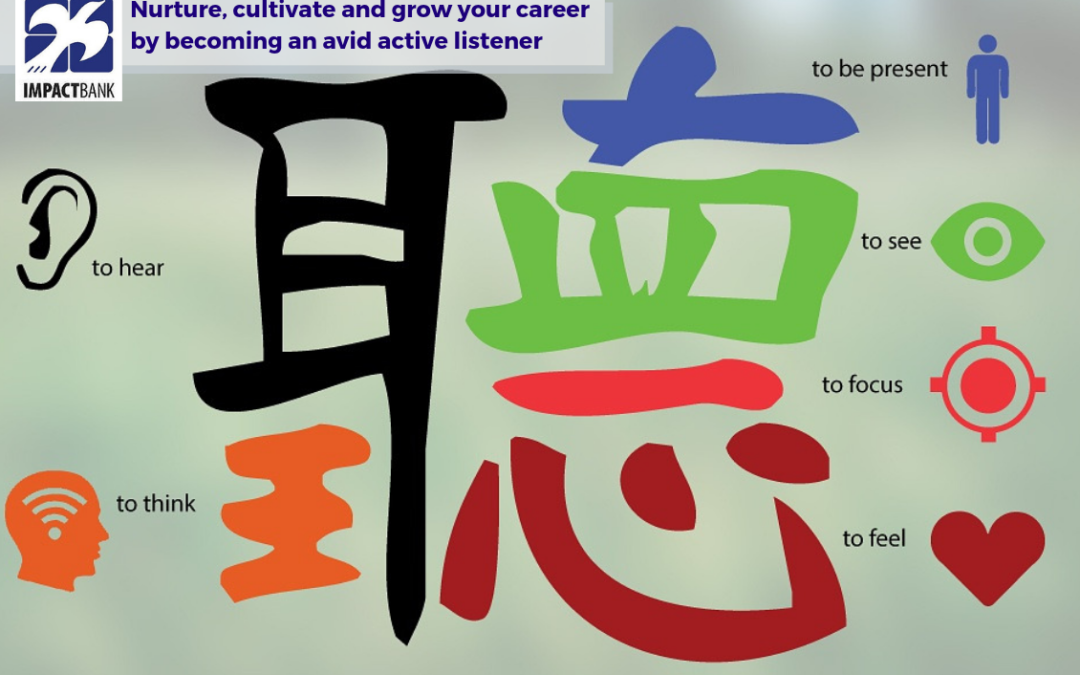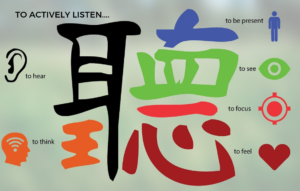When actively listening, people find they expand their influence, grow their presence while motivating through the power of belonging and cultivating meaningful resilience. In fact, when reviewing that list of benefits it’s clear why the skill of actively listening is one of the themes that weaves throughout my Bank Your Influence System.
This week’s podcast episode serves as an introduction to the theme, exploring it through lessons I learned from a past mentor: Dr. Barbara Daté. The weekly newsletter took a different approach by examining three problems people encounter when implementing an intentional listening practice. In the Wednesday video stories on LinkedIn and Instagram the emphasis is more on a significant benefit of building this skill: the ability to reduce assumptions and mitigate the impact of bias. Finally, this post brings it all together, briefly revisiting the cautionary message, expanding on a few key benefits, and wrapping with a section on the mitigation of bias.
Cautionary Tales
Essentially, the skill of actively listening is enormously powerful and positive. The need for caution comes as a result of how challenging it is to embed the skill gracefully into practice. Perhaps this speaks to the influential nature but I suspect it’s as much about how we, once comfortable with a skill, take it for granted, becoming lazy in the practice. For it to work effectively, humility is an essential component. Being more mindful of when the skill has become a loose or lazy habit, moving into over-use, will help in avoiding this pitfall. Applying the skill appropriately is more difficult early in a practice because people often fail to recognize the limitations to their capacity to use it effectively in a particular situation. Being sensitive is the most nebulous of the three as it speaks to self-awareness, self-regulation and rests in personal presence.
Over-Use
In this week’s newsletter I use a client story to explore the potential for over-use. When people are new to a skill of this sort, it often becomes a favourite toy and until becoming really skilled as an active listener, over-use becomes obvious and feels manipulative to those on the receiving-end.
Misapplication
Just as over-use can feel icky, misapplication of active listening will often feel like an interrogation. Here’s the thing, while a genuine approach with active listening can always add value, those who haven’t really practiced this skill, will often apply it sloppily and make matters worse. While there may be a genuinely positive intention, when active listening feels like an interrogation, the response is defensive and communication is broken.
Insensitivity
What is the intention? Actively listening is a powerful skill. Moreover, the listener is the one gaining input or insight or even ammunition. Does that sound dramatic? Think about who leaves a conversation with the most important information. Of course it’s the party who listened and made note of the point of view or perspective of the other. Ammunition for a future discussion, perhaps! As an active listener being sensitive to the influence gained is essential for trust to remain.
Benefits of Learning to Listen
Building relationships starts with the quality of communication skills. One thing to remember about communication is that it’s not a skill learned or acquired, it’s a skill that’s nurtured and cultivated throughout a life time. One relationship at a time. Whether I’m working with executives who’ve recognized the value throughout a long career or a 30-something manager or innovator, one thing is true for each and every client, communication skills are a key area of focus. Listening actively is the most difficult. It forms the foundation of all other areas of communication. Just look at the breakdown in this week’s feature image and consider how more effective listening skills will better prepare you to respond to the opportunities ahead of you.
Resilience
Resilience is a measure of persistently remaining in flow. To bounce back from adversity, you require clarity of purpose and focus. Most people are derailed by misunderstandings. Moreover, the active listener listens for understanding to see situations with greater clarity.
Influence
Exercising influence starts by cultivating trust. When doing the work to hear with the heart, rather than simply reacting to what the initial interpretation, an expansion of influence begins.
Presence
Being present and in-the-moment with people builds bonds of trust and loyalty. Actively listening for expanded presence is only possible with a deep self-awareness. Clearly, that’s part of the life-long communication journey of the skilled communicator. At the heart of presence is a chosen thinking pattern. An ideal way-of-thinking is one that wards off human bias or the learned assumptions that plague every human being. This open presence is an essential ingredient in building and maintaining the skill of the active listener.
Motivation
Baumeister’s research shows us that a person’s need to belong is the most powerful motivation to do anything. In other words, when people feel alienated by assumptions or bias, their interest and willingness to listen to another perspective is lost. Learning this must be the number one reason to work on this skill. Failing to see the value, is a failure to see the opportunity to make a significant difference in the world. Furthermore, isn’t that the best definition for living a successful life?
Actively Listening to Mitigate Bias
Earlier, I touched on this in a quick review of some of the benefits, but the mitigation of bias and release of foolish assumptions is worth a deeper dive.
Our inherent and inescapable attachment to our biases is a real problem. It shows up in misunderstandings, in judgments, in lazy thinking and limiting beliefs. It’s everywhere and it’s hurting our individual and collective performance. One skill that’s central to breaking bias is the capacity to actively listen. It starts with knowing bias exists in every human being. Then, choosing to mitigate its power by taking the time to seek understanding first.
In this week’s podcast episode I shared three guiding principles for practicing active listening. The first was listening with an eye to understanding, in the spirit of curiosity while resisting the instinct to react or interrogate. The second was to paraphrase back, to check-out whether there’s real understanding or whether a bias or assumption has clouded the message. This one step demonstrates a desire, at least a willingness, to try to understand. Thirdly, when responding, begin by demonstrating the message was received by describing where there may be common ground before expanding on a different perspective. This may not reduce the potential for conflict, but it may defuse it or reduce its intensity.
Building the skill of actively listening is an exercise in breaking bias and limiting hurtful assumptions. Three points of reflection worth considering…
What might I learn by being curious about the other person’s perspective that I can’t possibly learn when I’m the one talking?
How can I add value to this conversation if I don’t really know where the other person is coming from?
What if by understanding their perspective I will either be better able to offer another way to see this situation OR see the possibilities more clearly myself?
Walk With Me…
In April 2018 I brushed up against a call for meaning; an insight of sorts. It ultimately moved and inspired me to shift the focus of my practice. I’m walking with 30 something’s, who are in a pivotal spot in life and career. Whether HERE by age or spirit, I want to walk with these seekers! Seekers who are ready to do some self exploring & find the real meaning of their life? The research suggests people embrace their inner REBEL during their 20’s while most slip quietly and comfortably into ACCOMMODATOR in their 30’s. This documented pattern grabbed my attention and my mission was made clear. Moreover, I’m intent on resurfacing that inner rebel whose perspective, now shaped with more experience, may offer insights many typically miss when they matter most.
In June 2018 I took a course in story telling. I was intent on finding my “Big Why” to help me understanding my purpose for shifting my practice. Ultimately, I landed on my story. It spans from my childhood, with a pivotal point in my early 20’s finally culminating in a significant career turning-point at the age of 37. This story revealed an unhealthy pattern while illuminating my purpose. In fact, remembering the moment of insight supports my efforts when this transition is difficult. It adds meaning to the work I’m currently doing. Listen below…
Feel like you’re living someone else’s destiny?
Willing to do the work to find more meaning?
Once you have the skills to unpack the emotions and barriers and triggers and mindset challenges with the skills in my BYI system, you’ll begin to see the impact in your career and you’ll find what matters most to you. Join me…
My goal is to make my system accessible and affordable. There are many ways you can engage with me….below you’ll find THREE to get started, without spending a dime.
WALK WITH ME…
- REGISTER for an ASK ROX RoundTable… TWO 50 minute engagements on ZOOM – the second Tuesday and the last Friday of every month – limited to 12 participants in each.
- BOOK a complimentary exploratory conversation 20-30 minutes.
- SUBSCRIBE to my mailing list from my home page, receive an interactive exercise helping you cope with stress, and a weekly reflection.
Of course I’d love to work with you, your team or organization so…
- Book me to speak at your conference or to a group in your organization. My workshops on building resilience, improving relationships, and increasing performance are popular.



